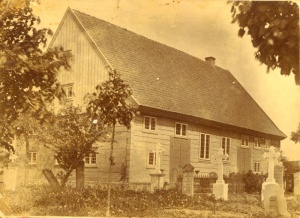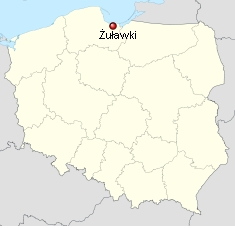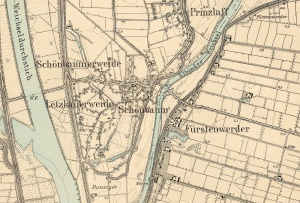Difference between revisions of "Fürstenwerder (Pomeranian Voivodeship, Poland)"
| [checked revision] | [checked revision] |
GameoAdmin (talk | contribs) (CSV import - 20130823) |
m (Text replace - "<em>Mennonitisches Lexikon</em>, 4 vols. Frankfurt & Weierhof: Hege; Karlsruhe: Schneider, 1913-1967: v. II," to "''Mennonitisches Lexikon'', 4 vols. Frankfurt & Weierhof: Hege; Karlsruhe: Schneider, 1913-1967: v. II,") |
||
| (9 intermediate revisions by the same user not shown) | |||
| Line 1: | Line 1: | ||
| − | [[File:Fuerstenwerder%20map.jpg|300px|thumb|right|''Żuławki (formerly Fürsternwerder)Source: [http://commons.wikimedia.org/wiki/Main_Page Wikipedia Commons] '']] | + | __FORCETOC__ |
| − | + | __TOC__ | |
| − | Source: [http://amzpbig.com/maps/1779_Schoneberg_1910.jpg Archiwum Map Zachodniej Polski]'']] | + | [[File:Fuerstenwerder%20map.jpg|300px|thumb|right|''Żuławki (formerly Fürsternwerder)<br /> |
| + | Source: [http://commons.wikimedia.org/wiki/Main_Page Wikipedia Commons] '']] | ||
| + | [[File:Fuerstenwerder%201910.jpg|300px|thumb|left|''Detailed map of Fürstenwerder, 1910.<br /> | ||
| + | Source: [http://amzpbig.com/maps/1779_Schoneberg_1910.jpg Archiwum Map Zachodniej Polski]'']] | ||
| + | [[File:Fuestenwerder.jpg|300px|thumb|right|''Fürsternwerder Mennonite Church<br /> | ||
| + | Source: Mennonite Library and Archives, North Newton<br /> | ||
| + | [http://mla.bethelks.edu/archives/numbered-photos/index_textonly.php Scanned Photo Collection]: 2003-0144'']] | ||
| + | [[File:Żuławki, mennonitský dům.JPG|300px|thumbnail|right|''Mennonite house in Fürstenwerder (now Żuławki, Poland).<br /> | ||
| + | Photo by Aktron.<br /> | ||
| + | Source: [http://commons.wikimedia.org/wiki/File:%C5%BBu%C5%82awki,_mennonitsk%C3%BD_d%C5%AFm.JPG Wikimedia Commons]''.]] | ||
| + | Fürstenwerder (now Żuławki; coordinates: 54.284722, 18.971389 [54° 17' 05" N 18° 58' 17" E]; population in 1852, 772; in 1905, 689; in 2012, 683), is located approximately 13 kilometres (8 miles) north-west of Nowy Dwór Gdański ([[Tiegenhof (Pomeranian Voivodeship, Poland)|Tiegenhof]]) and 24 km. (15 mi.) south-east of the regional capital Gdańsk ([[Danzig (Poland)|Danzig]]). It is located on the Elbing Vistula, near the "Danziger Haupt." | ||
Fürstenwerder was established by Winrich von Kniprode in 1352 under the Chełmno law (Kulm Law, a legal constitution for a municipal form of government) for 18 colonists. At the time, also a parish church was erected. In 1510, the village had 26 homesteads, including a village leader's farm, a parish priest, and 3 inns. During the following half century, the number of farms and inns decreased. In 1659, the village was burned by the Swedish army. | Fürstenwerder was established by Winrich von Kniprode in 1352 under the Chełmno law (Kulm Law, a legal constitution for a municipal form of government) for 18 colonists. At the time, also a parish church was erected. In 1510, the village had 26 homesteads, including a village leader's farm, a parish priest, and 3 inns. During the following half century, the number of farms and inns decreased. In 1659, the village was burned by the Swedish army. | ||
| Line 11: | Line 21: | ||
In 1772, Fürstenwerder had 17 Mennonite families with 81 persons. The 1776 census lists 16 Mennonite families with the following surnames: Bruhn, Claas(s)en, Dridger, Esau, Harder, Manteler, Plett, Reimer, van Bergen, van Riesen, Warckentin, and Wiebe. In 1820, the village had 564 residents, including 52 Mennonites. In 1889, the village had 794 residents, including 62 Mennonites. | In 1772, Fürstenwerder had 17 Mennonite families with 81 persons. The 1776 census lists 16 Mennonite families with the following surnames: Bruhn, Claas(s)en, Dridger, Esau, Harder, Manteler, Plett, Reimer, van Bergen, van Riesen, Warckentin, and Wiebe. In 1820, the village had 564 residents, including 52 Mennonites. In 1889, the village had 794 residents, including 62 Mennonites. | ||
| − | In 1853 Claas Epp, the Schulze of Fürstenwerder, | + | In 1853 Claas Epp, the Schulze of Fürstenwerder, immigrated to the province of Samara ([[Am Trakt Mennonite Settlement (Samara Oblast, Russia)|Am Trakt settlement]]), followed in 1859 and the following years by the preacher Cornelius Classen and finally also Elder Johann Wiebe to the Alt-Samara settlement in the same province. |
| − | |||
| − | |||
| − | |||
| − | |||
| − | + | The Fürstenwerder congregation was incorporated in 1880. In 1924 it had a membership of 540 souls. According to the <em>Gemeinde-Kalender</em> of 1941, the number of souls in 1940 was 556, of whom 450 were entitled to vote, and 106 were unbaptized children. The elder was Jakob Jantzen (preacher from 1894, elder 1911); preachers were Heinrich Dau (ordained 1912), Johannes Dyck (1919), Ernst Dyck (1928), Heinrich Wall (1934); the deacons were Gustav Wiens (1923) and Gustav Schulz (1928). Jakob Jantzen died an accidental death in 1942, and was succeeded as elder in 1943 by Johannes Dyck. The congregation was extinguished by evacuation westward before the advancing Russian army in 1945. | |
In 1990 the former church building was destroyed by fire. | In 1990 the former church building was destroyed by fire. | ||
= Bibliography = | = Bibliography = | ||
| − | Crous, Ernst. "Vom Pietismus bei den altpreussischen Mennoniten." <em>Mennonitische Geschichtsblätter | + | Crous, Ernst. "Vom Pietismus bei den altpreussischen Mennoniten." <em>Mennonitische Geschichtsblätter</em> 11 (1954): 13. |
| − | Hege, Christian and Christian Neff. | + | Hege, Christian and Christian Neff. ''Mennonitisches Lexikon'', 4 vols. Frankfurt & Weierhof: Hege; Karlsruhe: Schneider, 1913-1967: v. II, 21 f. |
| − | <em>Mitteilungen | + | <em>Mitteilungen der Konferenz der ost.- und westpreussischen Mennoni-tengemeinden, </em>Nos. 1-3 (September 1948, November 1943, and February 1944). A mimeographed copy in the Research Center at Göttingen. |
Penner, Horst. <em>Die ost- und westpreussischen Mennoniten in ihrem religiösen und sozialen Leben in ihren kulturellen und wirtschaftlichen Leistungen</em>, 2 vols. Weierhof, Germany: Mennonitischer Geschichtsverein, 1978-1987: v. 2, p. 251. | Penner, Horst. <em>Die ost- und westpreussischen Mennoniten in ihrem religiösen und sozialen Leben in ihren kulturellen und wirtschaftlichen Leistungen</em>, 2 vols. Weierhof, Germany: Mennonitischer Geschichtsverein, 1978-1987: v. 2, p. 251. | ||
| − | Wikipedia. "Żuławki." Web. 14 October 2012. | + | Wikipedia. "Żuławki." Web. 14 October 2012. http://en.wikipedia.org/wiki/%C5%BBu%C5%82awki. |
| + | |||
| + | Wolf, Hans-Jürgen. "Familienforschung in Westpreußen." Web. 14 October 2012. http://www.westpreussen.de/cms/ct/ortsverzeichnis/details.php?ID=1725. | ||
| − | |||
= Additional Information = | = Additional Information = | ||
| − | + | === Elders of the Grosses Werder Mennonite Church === | |
| + | |||
| + | {| border="1" | ||
| + | |- | ||
| + | !Elder | ||
| + | !Years of Service | ||
| + | |- | ||
| + | |Hans Siemens (d. 1644) | ||
| + | |22 Sep 1639-Feb 1644 | ||
| + | |- | ||
| + | |Peter Claassen | ||
| + | |31 Oct 1645–8 Oct 1679 | ||
| + | |- | ||
| + | |Harm Neufeld, (d. 1695) | ||
| + | |1676-1695 | ||
| + | |- | ||
| + | |Dirk Siemens (d. 1729), Tiegenhagen | ||
| + | |6 Sep 1695–24 Nov 1729 | ||
| + | |- | ||
| + | |Abraham Buhler, Co-Elder | ||
| + | |Until 1726 | ||
| + | |- | ||
| + | |Simon von Riesen (d. 1736), Klein Mausdorf | ||
| + | |18 Sep 1729–fall 1736 | ||
| + | |- | ||
| + | |Cornelius Andres (1680-1741), Tiegerweide | ||
| + | |7 Jun 1736–11 Jun 1741 | ||
| + | |- | ||
| + | |Hans Buhler, Klein Mausddorferfeld | ||
| + | |10 Sep 1741–29 Sep 1754 | ||
| + | |- | ||
| + | |Abraham Penner (d. 1766), Rueckenauerfeld | ||
| + | |2 Feb 1755–28 Nov 1766 | ||
| + | |- | ||
| + | |[[Thiessen, Dirk (1727-1806)|Dirk Thiessen]] (1727-1806), Petershagen | ||
| + | |1 Feb 1767–11 Jun 1806 | ||
| + | |- | ||
| + | |[[Warkentin, Cornelius (1740-1809)|Cornelius Warkentin]] (1740-1809), Rosenort | ||
| + | |13 Sep 1795–10 Jan 1809 | ||
| + | |} | ||
| + | === Fürstenwerder Mennonite Church Elders === | ||
| + | |||
| + | {| border="1" | ||
| + | |- | ||
| + | !Elder | ||
| + | !Years of Service | ||
| + | |- | ||
| + | |Isaak Schulz (1761-1834) | ||
| + | |20 Aug 1809–23 Aug 1834 | ||
| + | |- | ||
| + | |Jakob van Bergen (1789-1841) | ||
| + | |28 Sep 1834–28 Jun 1841 | ||
| + | |- | ||
| + | |Wilhelm Claassen (1799-1859) | ||
| + | |10 Oct 1841–23 Jul 1859 | ||
| + | |- | ||
| + | |[[Wiebe, Johann (1806-1872)|Johann Wiebe]] (1806-1872) | ||
| + | |19 Aug 1860–3 Oct 1869 | ||
| + | |- | ||
| + | |[[Regier, Peter (1825-1897)|Peter Regier]] (1825-1897) | ||
| + | |1 Feb 1874–3 Mar 1897 | ||
| + | |- | ||
| + | |Johannes Dyck (1853-1908) | ||
| + | |14 Jan 1892–20 Jun 1908 | ||
| + | |- | ||
| + | |Jakob Jantzen (1866-1942) | ||
| + | |15 Jan 1911-27 Sep 1942 | ||
| + | |- | ||
| + | |Johannes Dyck (1880-1960) | ||
| + | |1943-1945 | ||
| + | |} | ||
| + | = Map = | ||
| + | [[Map:Żuławki (Pomeranian Voivodeship, Poland)|Map:Żuławki (Pomeranian Voivodeship, Poland)]] | ||
{{GAMEO_footer|hp=Vol. 2, p. 427|date=April 2013|a1_last=Mannhardt|a1_first=H. G.|a2_last=Thiessen|a2_first=Richard D.}} | {{GAMEO_footer|hp=Vol. 2, p. 427|date=April 2013|a1_last=Mannhardt|a1_first=H. G.|a2_last=Thiessen|a2_first=Richard D.}} | ||
| + | [[Category:Places]] | ||
| + | [[Category:Cities, Towns, and Villages]] | ||
| + | [[Category:Cities, Towns, and Villages in Poland]] | ||
Revision as of 00:25, 16 January 2017

Source: Mennonite Library and Archives, North Newton
Scanned Photo Collection: 2003-0144
Fürstenwerder (now Żuławki; coordinates: 54.284722, 18.971389 [54° 17' 05" N 18° 58' 17" E]; population in 1852, 772; in 1905, 689; in 2012, 683), is located approximately 13 kilometres (8 miles) north-west of Nowy Dwór Gdański (Tiegenhof) and 24 km. (15 mi.) south-east of the regional capital Gdańsk (Danzig). It is located on the Elbing Vistula, near the "Danziger Haupt."
Fürstenwerder was established by Winrich von Kniprode in 1352 under the Chełmno law (Kulm Law, a legal constitution for a municipal form of government) for 18 colonists. At the time, also a parish church was erected. In 1510, the village had 26 homesteads, including a village leader's farm, a parish priest, and 3 inns. During the following half century, the number of farms and inns decreased. In 1659, the village was burned by the Swedish army.
Until 1772 Fürstenwerder was located in what was known as Royal Prussia (also known as Polish Prussia) in the Kingdom of Poland. The First Partition of Poland in 1772 resulted in the creation of a new province on 31 January 1773, called West Prussia, in which the village was located. Fürstenwerder was situated in the district (Kreis) of Marienburg until the establishment of the Free City of Danzig in 1920. The village came under the control of Nazi Germany during World War II until February 1945, when it was occupied by Soviet forces and returned to Poland. In 2013 Fürstenwerder (now known as Żuławki) was a village in the administrative district of Gmina Stegna, within Nowy Dwór Gdański County, Pomeranian Voivodeship.
Fürstenwerder was the name (since about 1830) of an independent Mennonite congregation, which formerly belonged to the "Flemish Mennonite congregation in the Grosse Werder" and was called the "Bärwald'sches Quartier"; from 1809 on was known as Bärwalde and had its own elder (Isaac Schulz, 1809-1834). Since 1768 there had been a meetinghouse in Fürstenwerder, which had been preserved without any important alterations until 1990. In 1768 the bishop of Culm, who in the name of the King of Poland had supreme ecclesiastical authority in the Grosse Werder, had permitted the overgrown Mennonite Grosses Werder congregation to erect four meetinghouses, whereas up to this time the Flemish Mennonites had only the church built in Rosenort in 1754. The new buildings were begun in Tiegenhagen, Ladekopp, Fürstenwerder, and Heubuden, on the condition that the Mennonites build and perpetually maintain a Catholic chapel on Möskenberg at Petershagen. The buildings were progressing well, when in the summer of 1768 the bishop suddenly forbade and forcibly prohibited their completion. The reason was this: Anna Steffen, the only daughter of Jakob Steffen, a Mennonite resident of Tiegenhagen, was with her own consent abducted by Catholic nuns with aid of the Tiegenhagen priest, taken to Culm, and married to a Pole. Since the girl was still a minor, the parents demanded her surrender, and finding no hearing from the bishop they appealed to the King of Prussia, who had control of the Elbing region as a special right from Poland. The king ordered the bishop to release the girl; but now the bishop visited his wrath on all the Mennonites of the Grossen Werder, by prohibiting the completion of the four buildings, and declared that he would not consent to having them finished until they stopped bothering him about Steffen. At the end of October he gave his consent and the buildings were finished. The Catholic chapel in Petershagen, which was finished at the same time, was burned down by lightning in 1778 and was not rebuilt. The Mennonites terminated their obligation by paying a lump sum.
In 1772, Fürstenwerder had 17 Mennonite families with 81 persons. The 1776 census lists 16 Mennonite families with the following surnames: Bruhn, Claas(s)en, Dridger, Esau, Harder, Manteler, Plett, Reimer, van Bergen, van Riesen, Warckentin, and Wiebe. In 1820, the village had 564 residents, including 52 Mennonites. In 1889, the village had 794 residents, including 62 Mennonites.
In 1853 Claas Epp, the Schulze of Fürstenwerder, immigrated to the province of Samara (Am Trakt settlement), followed in 1859 and the following years by the preacher Cornelius Classen and finally also Elder Johann Wiebe to the Alt-Samara settlement in the same province.
The Fürstenwerder congregation was incorporated in 1880. In 1924 it had a membership of 540 souls. According to the Gemeinde-Kalender of 1941, the number of souls in 1940 was 556, of whom 450 were entitled to vote, and 106 were unbaptized children. The elder was Jakob Jantzen (preacher from 1894, elder 1911); preachers were Heinrich Dau (ordained 1912), Johannes Dyck (1919), Ernst Dyck (1928), Heinrich Wall (1934); the deacons were Gustav Wiens (1923) and Gustav Schulz (1928). Jakob Jantzen died an accidental death in 1942, and was succeeded as elder in 1943 by Johannes Dyck. The congregation was extinguished by evacuation westward before the advancing Russian army in 1945.
In 1990 the former church building was destroyed by fire.
Bibliography
Crous, Ernst. "Vom Pietismus bei den altpreussischen Mennoniten." Mennonitische Geschichtsblätter 11 (1954): 13.
Hege, Christian and Christian Neff. Mennonitisches Lexikon, 4 vols. Frankfurt & Weierhof: Hege; Karlsruhe: Schneider, 1913-1967: v. II, 21 f.
Mitteilungen der Konferenz der ost.- und westpreussischen Mennoni-tengemeinden, Nos. 1-3 (September 1948, November 1943, and February 1944). A mimeographed copy in the Research Center at Göttingen.
Penner, Horst. Die ost- und westpreussischen Mennoniten in ihrem religiösen und sozialen Leben in ihren kulturellen und wirtschaftlichen Leistungen, 2 vols. Weierhof, Germany: Mennonitischer Geschichtsverein, 1978-1987: v. 2, p. 251.
Wikipedia. "Żuławki." Web. 14 October 2012. http://en.wikipedia.org/wiki/%C5%BBu%C5%82awki.
Wolf, Hans-Jürgen. "Familienforschung in Westpreußen." Web. 14 October 2012. http://www.westpreussen.de/cms/ct/ortsverzeichnis/details.php?ID=1725.
Additional Information
Elders of the Grosses Werder Mennonite Church
| Elder | Years of Service |
|---|---|
| Hans Siemens (d. 1644) | 22 Sep 1639-Feb 1644 |
| Peter Claassen | 31 Oct 1645–8 Oct 1679 |
| Harm Neufeld, (d. 1695) | 1676-1695 |
| Dirk Siemens (d. 1729), Tiegenhagen | 6 Sep 1695–24 Nov 1729 |
| Abraham Buhler, Co-Elder | Until 1726 |
| Simon von Riesen (d. 1736), Klein Mausdorf | 18 Sep 1729–fall 1736 |
| Cornelius Andres (1680-1741), Tiegerweide | 7 Jun 1736–11 Jun 1741 |
| Hans Buhler, Klein Mausddorferfeld | 10 Sep 1741–29 Sep 1754 |
| Abraham Penner (d. 1766), Rueckenauerfeld | 2 Feb 1755–28 Nov 1766 |
| Dirk Thiessen (1727-1806), Petershagen | 1 Feb 1767–11 Jun 1806 |
| Cornelius Warkentin (1740-1809), Rosenort | 13 Sep 1795–10 Jan 1809 |
Fürstenwerder Mennonite Church Elders
| Elder | Years of Service |
|---|---|
| Isaak Schulz (1761-1834) | 20 Aug 1809–23 Aug 1834 |
| Jakob van Bergen (1789-1841) | 28 Sep 1834–28 Jun 1841 |
| Wilhelm Claassen (1799-1859) | 10 Oct 1841–23 Jul 1859 |
| Johann Wiebe (1806-1872) | 19 Aug 1860–3 Oct 1869 |
| Peter Regier (1825-1897) | 1 Feb 1874–3 Mar 1897 |
| Johannes Dyck (1853-1908) | 14 Jan 1892–20 Jun 1908 |
| Jakob Jantzen (1866-1942) | 15 Jan 1911-27 Sep 1942 |
| Johannes Dyck (1880-1960) | 1943-1945 |
Map
Map:Żuławki (Pomeranian Voivodeship, Poland)
| Author(s) | H. G. Mannhardt |
|---|---|
| Richard D. Thiessen | |
| Date Published | April 2013 |
Cite This Article
MLA style
Mannhardt, H. G. and Richard D. Thiessen. "Fürstenwerder (Pomeranian Voivodeship, Poland)." Global Anabaptist Mennonite Encyclopedia Online. April 2013. Web. 16 Apr 2024. https://gameo.org/index.php?title=F%C3%BCrstenwerder_(Pomeranian_Voivodeship,_Poland)&oldid=145210.
APA style
Mannhardt, H. G. and Richard D. Thiessen. (April 2013). Fürstenwerder (Pomeranian Voivodeship, Poland). Global Anabaptist Mennonite Encyclopedia Online. Retrieved 16 April 2024, from https://gameo.org/index.php?title=F%C3%BCrstenwerder_(Pomeranian_Voivodeship,_Poland)&oldid=145210.
Adapted by permission of Herald Press, Harrisonburg, Virginia, from Mennonite Encyclopedia, Vol. 2, p. 427. All rights reserved.
©1996-2024 by the Global Anabaptist Mennonite Encyclopedia Online. All rights reserved.



